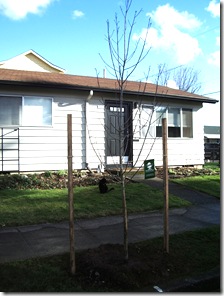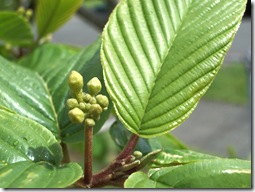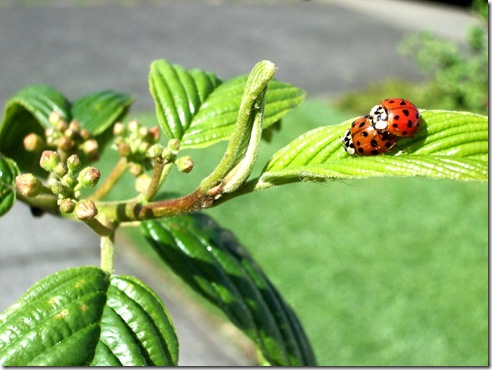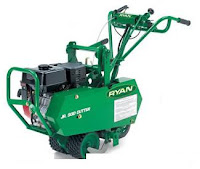In part three of this series, I told you about removing existing lawn and landscape plants to create a "blank slate". With that done, we can prepare the site for the new landscape installation.
I mentioned briefly before that now is the time to install any hardscapes and correct any slope issues. Make sure that your soil slopes gently away from foundations, to prevent basement or crawlspace moisture problems. If you want to create small mounds or berms, you can use dirt (or some of your removed sod) to do that now. Are you installing a paver patio? Do you want to create a rain garden that catches water from your disconnected downspouts? (Mike, over at Slugyard, just
built a nice rain garden.)
The only hardscape improvements that I installed during my re-make, were a gravel patio and a low retaining wall constructed with landscape block (home centers have many sizes and varieties of interlocking blocks). We didn't have room in our yard for a full-blown rain garden, but I did want to create a catchment for the runoff from one disconnected downspout. The water flows through a pipe under the patio, and into a gravel-filled hole. Any overflow is channeled through a mini "creek" toward the street.
 |
| Gravel patio with plastic edging, and low retaining wall. The gravel "creek" is actually a gravel-filled hole near the patio, where the drainage from a downspout is collected, then the overflow would drain toward the sidewalk. |
You have to be careful when you're disconnecting downspouts and creating new drainage points. You want to make sure that you have enough area to hold the water while it soaks in to the ground, which depends on how large of a roof area you're draining. There are some rules, too, about how far from adjoining property lines a drainage point must be. You can get some good information about that and other things to consider (plus information about the disconnection incentive program), from this PDF by the City of Portland Environmental Services:
http://www.portlandonline.com/bes/index.cfm?c=43081&a=177702
With all of your slope issues corrected and your hardscapes installed, it's time to think about weed barrrier. There are various landscape "fabrics" available from any home and garden center. These materials allow air and water to pass through, but prevent weeds from growing up, or from penetrating down to get established in the soil. For greener options, there are choices like newspaper or cardboard. Either can be laid out in the desired shape, then wet thoroughly to stay in place. I didn't have a good source for old newspaper, and since I was working on a rental property I really wanted to take the easiest path to what I felt would be the best weed prevention for a low-maintenance yard. I opted for the landscape fabric. I would never recommend using plastic of any kind, which would rob the soil of oxygen and moisture. And another note: I was creating what would be a fairly static landscape once complete. If you're going to be doing a lot of transplanting and ongoing gardening in your yard, I wouldn't use landscape cloth at all - or not in those areas, anyway. If you'll just be adding plants over time, the cloth works fine - you can pull the mulch aside and cut a new hole. Actually I cut a "plus sign" in the cloth, then fold the corners under to create a square opening. After you put the plant in, you can then pull the corners back out to cover as much of the exposed dirt as possible.
 |
| Landscape fabric being covered with Hemlock mulch |
The landscape fabric usually comes with some metal, U-shaped "staples" which can be pushed through the fabric and into the ground, to hold the fabric in place. I would suggest buying an extra box (at least) of the staples - especially if you have lots of curves in your design. The more involved shapes generally require more staples than a straight run. I would also suggest starting with any straight runs that you do have first, then coming back and trimming in the curves or small sections. You'll want to overlap each row by a few inches. Don't waste staples by stapling down both edges of your first row. Where the rows overlap, you can use one staple to go through two layers. One other tip... If you're putting fabric down on a slope, start at the bottom with your first row, and work your way up - just like you would with roofing shingles. That way, when you're putting the mulch on, it won't slide underneath the upper edge of each row and create a problem.
Ready to cover up your landscape cloth or newspaper? What kind of mulch do you want to use? There are plenty of choices out there - standard bark mulch (of which there are many kinds), nut shells, pine needles, leaf mulch, rock, recycled rubber mulch, and the list goes on. They all have pros and cons, some of which are listed on
LoveToKnow. For my landscape, I chose medium Hemlock bark. I like the rich, natural color and most of all, I like the fact that Hemlock bark does not have the tiny slivers that fir bark does. You can get your hands dirty without fear of splinters!
There are endless sources of bark dust and other mulching materials, from bagged quantities at your local home center, to pick-up loads from your landscape supply or "fuel" companies around town. You can definitely save some money by going with the pick-up load. They'll load it in seconds with their heavy machinery, and they typically measure by the yard (cubic yard). Even the smallest of city trucks like mine can hold a yard, and they generally will sell a half yard if you don't need that much. You can have it delivered as well. How much mulch does a mulch buyer need? There's a handy guide to help you figure it out, over at
About.com. Our source for gravel of all sizes, landscape rock, and mulch is
Mt. Scott Fuel, on SE Foster Road. I would recommend them to anyone in SE Portland.
With such an open, clean slate to work with, spreading the mulch is easy. Just use a shovel to transfer it from truck to wheel barrow, dump the wheel barrow, and use a metal rake to spread the mulch to about 3" deep.
That's probably enough work for one day, and it's a good stopping point for this post. So next time, in the fifth and final part of this series, we'll take a look at some basic planting principles, some good native plant choices, and some local sources, too.
Until then, thanks for reading!
 |
| Another "creek" - installed over the landscape fabric, to accommodate disconnection of the pictured downspout. |












































